Rudolph Valentino: An Unlikely Australian Idol
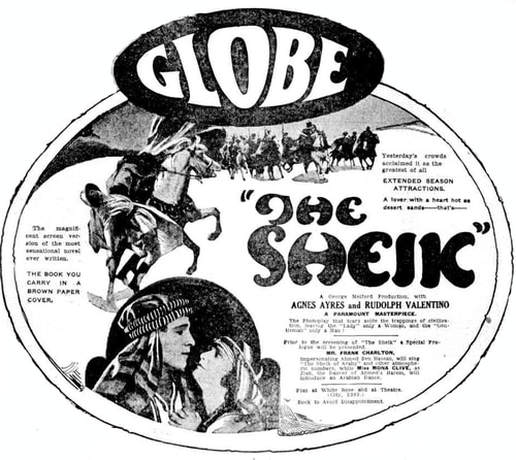 Newspaper Advertisement. Source: Sunday Times (Sydney), 26 February 1922.
Newspaper Advertisement. Source: Sunday Times (Sydney), 26 February 1922.
This essay was my contribution to the 2015 Rudolph Valentino Blogathon, hosted by Timeless Hollywood.
On the evening of Saturday 25th February 1922, The Sheik, starring Rudolph Valentino, made its Australian debut. The Globe Theatre, which sat just across the road from the Queen Victoria Markets in the heart of Sydney’s George Street entertainment district, had been newly redecorated for the occasion. A humid late summer night made the theatre every bit as balmy as the deserts of North Africa in which The Sheik was set, and an exotic Eastern perfume wafted through the auditorium. Audience members, shown to their seats by an army of ushers in Middle Eastern garb, settled in to enjoy a live stage prologue depicting Ahmed Ben Hassan's desert camp. A dancer, Mona Clive, performed a sensual slave girl dance before the lights went down for the main attraction.
Having signed a deal with the Australian arm of Famous Players-Lasky/Paramount Pictures, Union Theatres had spent months preparing for this moment. They had closely watched the cult of The Sheik grow in America, and carefully laid the groundwork for what might be a similar hit on home turf.
Central to their strategy was a recent decision to designate the Globe Theatre an ‘extended play’ theatre. Patterns of distribution usually demanded that a film play for only one week, or two at most if it was extraordinarily popular. At the Globe, seasons would be open ended, lasting for as long as audiences kept coming. If The Sheik proved as popular as it had in America, the film could be given a much longer run - perhaps five or even six weeks!
On the evening of Saturday 25th February 1922, The Sheik, starring Rudolph Valentino, made its Australian debut. The Globe Theatre, which sat just across the road from the Queen Victoria Markets in the heart of Sydney’s George Street entertainment district, had been newly redecorated for the occasion. A humid late summer night made the theatre every bit as balmy as the deserts of North Africa in which The Sheik was set, and an exotic Eastern perfume wafted through the auditorium. Audience members, shown to their seats by an army of ushers in Middle Eastern garb, settled in to enjoy a live stage prologue depicting Ahmed Ben Hassan's desert camp. A dancer, Mona Clive, performed a sensual slave girl dance before the lights went down for the main attraction.
Having signed a deal with the Australian arm of Famous Players-Lasky/Paramount Pictures, Union Theatres had spent months preparing for this moment. They had closely watched the cult of The Sheik grow in America, and carefully laid the groundwork for what might be a similar hit on home turf.
Central to their strategy was a recent decision to designate the Globe Theatre an ‘extended play’ theatre. Patterns of distribution usually demanded that a film play for only one week, or two at most if it was extraordinarily popular. At the Globe, seasons would be open ended, lasting for as long as audiences kept coming. If The Sheik proved as popular as it had in America, the film could be given a much longer run - perhaps five or even six weeks!
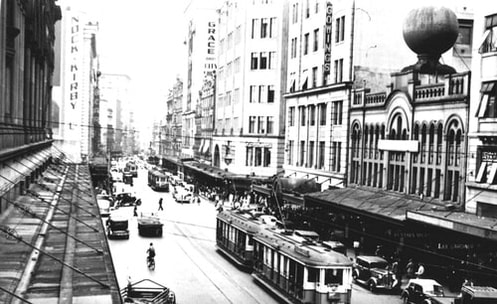 The Globe Theatre (right), unofficial home of Sydney's Valentino fandom during the early 1920s.
The Globe Theatre (right), unofficial home of Sydney's Valentino fandom during the early 1920s.
Not in their wildest dreams could they have predicted that this would be the beginning of one of the most extraordinary seasons in Australia's early film history.
“Day and night outside the Globe Theatre in George Street people formed a double line in a slowly shuffling queue that awaited its turn for admittance to the holy of holies - perfumed with Indasia soap, fragrance of the Orient!” remembered Sue Crowley, a sixteen year old at the time. After much begging, she was finally permitted to see The Sheik - so long as she agreed to take along her younger brother.
“So we two joined that seemingly endless queue, eventually to be ushered into the hot darkness reeking of the perfumes of Arabia, and fumbled our way to our seats,” she recalled. “Before the screening, a majestic figure stepped from behind the heavy folds of the curtains. A well known baritone of the day, Frank Charlton, clad in the robes of a sheik, sang with feeling in deep, fruity tones:
I’m the Sheik of Araby,
Your love belongs to me,
At night when you’re asleep,
Into your tent I’ll creep.
And the stars that shine above
Will light our way to love…
"Gripping the arms of my seat, I was mesmerised by the rhythm of hoof beats as Rudolph, in one sublime movement, swept that lucky, lucky Agnes Ayres boldly into his arms. Noisily thumped my heart. And that fool of a woman actually resisted! Five times I sneaked in to see The Sheik, and if I hadn’t run out of pocket money it might well have been five hundred.”
“Day and night outside the Globe Theatre in George Street people formed a double line in a slowly shuffling queue that awaited its turn for admittance to the holy of holies - perfumed with Indasia soap, fragrance of the Orient!” remembered Sue Crowley, a sixteen year old at the time. After much begging, she was finally permitted to see The Sheik - so long as she agreed to take along her younger brother.
“So we two joined that seemingly endless queue, eventually to be ushered into the hot darkness reeking of the perfumes of Arabia, and fumbled our way to our seats,” she recalled. “Before the screening, a majestic figure stepped from behind the heavy folds of the curtains. A well known baritone of the day, Frank Charlton, clad in the robes of a sheik, sang with feeling in deep, fruity tones:
I’m the Sheik of Araby,
Your love belongs to me,
At night when you’re asleep,
Into your tent I’ll creep.
And the stars that shine above
Will light our way to love…
"Gripping the arms of my seat, I was mesmerised by the rhythm of hoof beats as Rudolph, in one sublime movement, swept that lucky, lucky Agnes Ayres boldly into his arms. Noisily thumped my heart. And that fool of a woman actually resisted! Five times I sneaked in to see The Sheik, and if I hadn’t run out of pocket money it might well have been five hundred.”
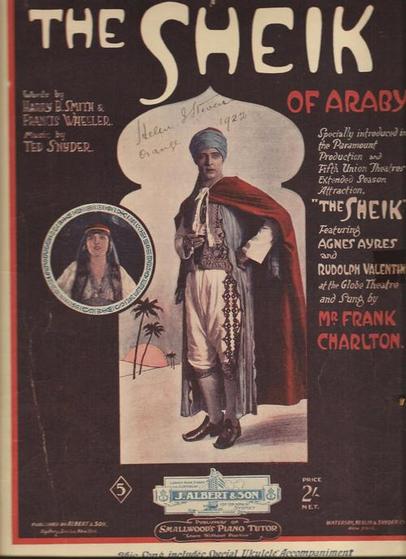 Sheet Music commemorating 'The Sheik's record run at Sydney's Globe Theatre. Source: Author's Collection.
Sheet Music commemorating 'The Sheik's record run at Sydney's Globe Theatre. Source: Author's Collection.
Sydney had never experienced an obsession like the one which grew up around The Sheik. Typists, shop assistants, teenage schoolgirls, respectable married women, young and old, high society and working class - all clamoured to see what all the fuss was about. Once they had learned, they returned - again, and again, and again. Even when only a third of the way through its run, The Sheik was being described as the most popular film ever to be shown in Australia.
Patrons bought commemorative sheet music, and toted portraits of Valentino that had been specially scented with the same oriental perfume used in the theatre. The book on which the film was based catapulted to the top of the bestseller list, with Sydney booksellers shifting 500 copies per day. The season was extended again and again, to the point that other prints had to be rushed into distribution so that the film could debut in other major Australian cities.
The question on every Sydneysider's lips was not "Have you seen The Sheik?" but "How many times have you seen The Sheik?" Some women boasted of attending twice a week or more, for months on end. Repeat attendances accounted for an estimated 35% of business, at a time when seeing a film twice was rare, and such obsessive re-attendance virtually unknown. It is fair to describe The Sheik as Australia's first cult film.
The Globe Theatre eventually hosted The Sheik five times a day, six days a week, for an unprecedented twenty-four weeks - nearly six months in total, representing over 700 showings. Even then, audiences could not get enough. After its final screening at the Globe on 11 August 1922, it was transferred to another city theatre, the Empress, for a further month. In late 1923, The Sheik returned to the Globe, playing for yet another six weeks. Nothing had ever come close to its success. This was not only the longest continuous run in Australian film history, but one of the longest anywhere in the world at that time.
Integral to its triumph was its exotic, almond-eyed leading man, Rudolph Valentino, a star entirely unlike anyone who had come before him. Several of Valentino’s earlier films had been shown in Australia, though it was not until Uncharted Seas (1921) that he was singled out in reviews. The Sheik, however, turned Rudolph Valentino into the hottest name in Australian cinema.
As Union Theatres expedited the release of his upcoming films, other distributors who held the rights to Valentino’s unreleased pictures now rushed to clear their backlog. Sydneysiders saw no less than six new Valentino features during the remainder of 1922 - Moran of the Lady Letty in June, 4 Horsemen of the Apocalypse in September, Stolen Moments in October, Beyond the Rocks in November, and Blood and Sand and The Delicious Little Devil in December.
Patrons bought commemorative sheet music, and toted portraits of Valentino that had been specially scented with the same oriental perfume used in the theatre. The book on which the film was based catapulted to the top of the bestseller list, with Sydney booksellers shifting 500 copies per day. The season was extended again and again, to the point that other prints had to be rushed into distribution so that the film could debut in other major Australian cities.
The question on every Sydneysider's lips was not "Have you seen The Sheik?" but "How many times have you seen The Sheik?" Some women boasted of attending twice a week or more, for months on end. Repeat attendances accounted for an estimated 35% of business, at a time when seeing a film twice was rare, and such obsessive re-attendance virtually unknown. It is fair to describe The Sheik as Australia's first cult film.
The Globe Theatre eventually hosted The Sheik five times a day, six days a week, for an unprecedented twenty-four weeks - nearly six months in total, representing over 700 showings. Even then, audiences could not get enough. After its final screening at the Globe on 11 August 1922, it was transferred to another city theatre, the Empress, for a further month. In late 1923, The Sheik returned to the Globe, playing for yet another six weeks. Nothing had ever come close to its success. This was not only the longest continuous run in Australian film history, but one of the longest anywhere in the world at that time.
Integral to its triumph was its exotic, almond-eyed leading man, Rudolph Valentino, a star entirely unlike anyone who had come before him. Several of Valentino’s earlier films had been shown in Australia, though it was not until Uncharted Seas (1921) that he was singled out in reviews. The Sheik, however, turned Rudolph Valentino into the hottest name in Australian cinema.
As Union Theatres expedited the release of his upcoming films, other distributors who held the rights to Valentino’s unreleased pictures now rushed to clear their backlog. Sydneysiders saw no less than six new Valentino features during the remainder of 1922 - Moran of the Lady Letty in June, 4 Horsemen of the Apocalypse in September, Stolen Moments in October, Beyond the Rocks in November, and Blood and Sand and The Delicious Little Devil in December.
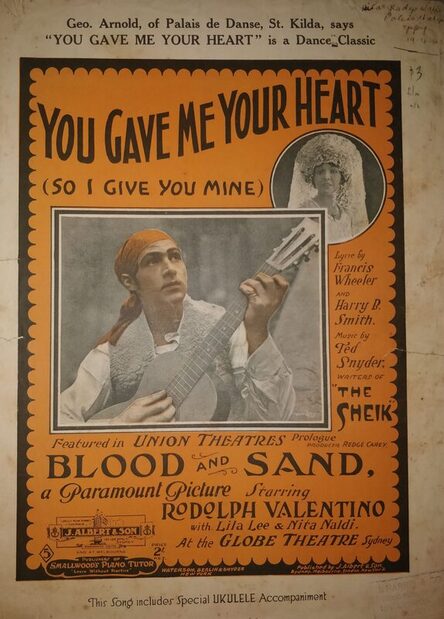 Sheet Music commemorating the Sydney season of 'Blood and Sand'. Source: Author's Collection.
Sheet Music commemorating the Sydney season of 'Blood and Sand'. Source: Author's Collection.
Besides The Sheik, the most popular of Valentino's films in Australia was Blood and Sand, which succeeded The Sheik at the Globe Theatre, helping to boost its credentials as the unofficial Sydney headquarters of the Valentino fandom. After an eight week season, it played a further month at other city theatres, sometimes at more than one simultaneously.
Though this seems paltry behind The Sheik’s blockbuster run, it was still considered a phenomenal performance at the time. Blood and Sand was also revived at the Globe in November 1924 - the last film that would ever play there, in fact. Paramount Pictures decided to designate the luxurious new Prince Edward Theatre as the home of its prestige productions, and the Globe was shuttered at the end of 1924. The lower level was transformed into a shopping arcade, and the upper level later became a radio studio.
Metro were somewhat slower in exploiting Valentino’s newfound Australian fame, though this was not their own fault. Their presence in the Australian market was minor compared to Paramount’s, and their films were currently distributed by a small company, the Co-Operative Film Exchange. For Four Horsemen of the Apocalypse, Co-Operative were able to broker a deal with the larger Union Theatres chain, allowing the film to appear at Sydney's most prestigious cinema, the Crystal Palace, where it was shown for seven weeks before moving on to other city theatres.
By mid 1923, Co-Operative had ceded control of Metro's films in Australia to Feature Films Ltd, the same representatives of Famous Players-Lasky/Paramount who had already overseen the local release of Valentino's features for that company. Given the massive success of The Sheik, it is likely that Valentino's personal fame and drawing power inspired this corporate take-over. As the lengthy negotiations over Four Horsemen had proven, Valentino was now too big to be entrusted to a minor distributor.
Perhaps due to this corporate disruption, the golden touch that the company had demonstrated with The Sheik deserted them for The Conquering Power, whose Sydney season played out at the relatively minor Piccadilly Theatre. Though it performed well, its impact was somewhat more muted than its predecessor. Without the exotic and evocative setting of the earlier film, the best publicity men could think of to promote it was a competition that promised three guineas to whoever could best answer the question 'Why is Rudolph Valentino the perfect lover?' While the winner, a T. Digby of Marrickville, put it salaciously and succinctly - "He knows why, he knows how, and he does it," - the second placegetter, Mrs Deane Gregg, provided a view more poignant, and perhaps more accurate: "He gives beauty and thought and hope to the unbeloved." For thousands of women, regarded as little more than cooks and cleaners by their husbands, Valentino and his films represented an oasis of romance.
Though this seems paltry behind The Sheik’s blockbuster run, it was still considered a phenomenal performance at the time. Blood and Sand was also revived at the Globe in November 1924 - the last film that would ever play there, in fact. Paramount Pictures decided to designate the luxurious new Prince Edward Theatre as the home of its prestige productions, and the Globe was shuttered at the end of 1924. The lower level was transformed into a shopping arcade, and the upper level later became a radio studio.
Metro were somewhat slower in exploiting Valentino’s newfound Australian fame, though this was not their own fault. Their presence in the Australian market was minor compared to Paramount’s, and their films were currently distributed by a small company, the Co-Operative Film Exchange. For Four Horsemen of the Apocalypse, Co-Operative were able to broker a deal with the larger Union Theatres chain, allowing the film to appear at Sydney's most prestigious cinema, the Crystal Palace, where it was shown for seven weeks before moving on to other city theatres.
By mid 1923, Co-Operative had ceded control of Metro's films in Australia to Feature Films Ltd, the same representatives of Famous Players-Lasky/Paramount who had already overseen the local release of Valentino's features for that company. Given the massive success of The Sheik, it is likely that Valentino's personal fame and drawing power inspired this corporate take-over. As the lengthy negotiations over Four Horsemen had proven, Valentino was now too big to be entrusted to a minor distributor.
Perhaps due to this corporate disruption, the golden touch that the company had demonstrated with The Sheik deserted them for The Conquering Power, whose Sydney season played out at the relatively minor Piccadilly Theatre. Though it performed well, its impact was somewhat more muted than its predecessor. Without the exotic and evocative setting of the earlier film, the best publicity men could think of to promote it was a competition that promised three guineas to whoever could best answer the question 'Why is Rudolph Valentino the perfect lover?' While the winner, a T. Digby of Marrickville, put it salaciously and succinctly - "He knows why, he knows how, and he does it," - the second placegetter, Mrs Deane Gregg, provided a view more poignant, and perhaps more accurate: "He gives beauty and thought and hope to the unbeloved." For thousands of women, regarded as little more than cooks and cleaners by their husbands, Valentino and his films represented an oasis of romance.
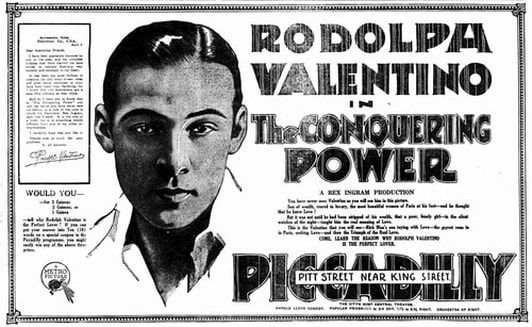 Newspaper Advertisement. Source: Sunday Times (Sydney), 8 July 1923.
Newspaper Advertisement. Source: Sunday Times (Sydney), 8 July 1923.
Meanwhile, the release of Camille in September 1923 was so low-key that many fans missed it altogether. Advertisements were almost non-existent, and the film seems to have played only a single week in Sydney, with similarly truncated seasons in other Australian capitals.
Months after it had already come and gone, letters continued to pour in to magazine columns, asking when it would be arriving. The apparent lack of faith on the part of its promoters may have to do with the film’s poor performance in America, where it was considered too artsy and mannered for even Valentino’s charisma to rescue it.
One thing remained certain - Australians were hooked on Rudolph Valentino, or Rodolph, as they were informed was his preferred spelling. Sydney’s most comprehensive cinema coverage was to be found in the Sunday Times, which published a column known as 'The Movie Know-All’ during the period of Rudy’s greatest popularity. Aside from the huge number of questions to the anonymous 'Know-All’ about Valentino’s life, marital status and upcoming films, the sheer number of correspondents who gave themselves pseudonyms such as 'Sheik’, 'Rudolph’ or 'The Young Rajah’ testifies to his popularity.
“I’ve chosen this name, as The Sheik, which I saw 17 times, is in my opinion, the best film ever displayed,” explained one fan. “Next comes The Four Horsemen of the Apocalypse, which I saw five times … He has been a favourite of mine ever since I saw him in Once to Every Woman, long before The Sheik. Anything you may publish, re Rodolph Valentino or my other favourites will meet with my very greatest approval. I have about 70 photos of him now.”
As in America, there were a few jealous dissenters. “I hate the Sheik. I think he’s a "he-vamp,” and I hate the way he rolls his eyes,“ wrote another correspondent, who signed himself only as 'Man’. "I know Sydney girls have got Rudolphitis, and I know that my young wife sees the Sheik in everything - the grilling steak holds his image - the wringer holds his spirit - the meat safe is redolent of him. But I hate him … Girls who see romance in the Sheik would see romance in the butcher’s boy. They represent decadent Flapperitis in its most advanced stage. Give me a man like 'Bill’ Hart, who represents manhood in its greatest sense.”
Other readers rushed to defend their idol. “I think 'Man’ is cruel to attack Rudolph Valentino in the way he does,” wrote one woman. “I can imagine him as a smug, suburban-minded prig with as much romance in his soul as a bus horse. To me, Rudolph Valentino is divine. I have been forced to a blighted life in which the only romance has been borrowed from books and pictures. And that is why I love Rudolph Valentino. He is beautiful and romantic and every girl’s heart must respond to him … I think the Arabian desert, the Sheik himself, the glorious air of adventure in the picture must give any girl a thrill, and all I can say is that "Man,” with a temperament as revealed in his little article, must be as dull as a tomb stone.“
In any case, "Man” found himself far outnumbered. Paramount’s representative in Australia, Frank Deane, returned from an overseas tour in 1925 to report that Valentino received more fan letters from Australia than from any other foreign country.
By 1924, the supply of current Valentino movies had slowed to a trickle. The Young Rajah, appearing in May that year, was somewhat less successful than its predecessors, playing only a single week at Sydney's Haymarket and Strand Theatres. Perhaps this was due to market saturation; perhaps it was simply not a very good film. Valentino personally disliked it, and it played a strong role in the severance of his relationship with Paramount Pictures. Australian distributors were eventually forced to dip very low into the backlog, releasing such minor efforts as All Night (1918), and A Society Sensation (1918) - one of several films that were recut in the wake of Valentino’s stardom, in order to bring greater prominence to his comparatively minor role.
Months after it had already come and gone, letters continued to pour in to magazine columns, asking when it would be arriving. The apparent lack of faith on the part of its promoters may have to do with the film’s poor performance in America, where it was considered too artsy and mannered for even Valentino’s charisma to rescue it.
One thing remained certain - Australians were hooked on Rudolph Valentino, or Rodolph, as they were informed was his preferred spelling. Sydney’s most comprehensive cinema coverage was to be found in the Sunday Times, which published a column known as 'The Movie Know-All’ during the period of Rudy’s greatest popularity. Aside from the huge number of questions to the anonymous 'Know-All’ about Valentino’s life, marital status and upcoming films, the sheer number of correspondents who gave themselves pseudonyms such as 'Sheik’, 'Rudolph’ or 'The Young Rajah’ testifies to his popularity.
“I’ve chosen this name, as The Sheik, which I saw 17 times, is in my opinion, the best film ever displayed,” explained one fan. “Next comes The Four Horsemen of the Apocalypse, which I saw five times … He has been a favourite of mine ever since I saw him in Once to Every Woman, long before The Sheik. Anything you may publish, re Rodolph Valentino or my other favourites will meet with my very greatest approval. I have about 70 photos of him now.”
As in America, there were a few jealous dissenters. “I hate the Sheik. I think he’s a "he-vamp,” and I hate the way he rolls his eyes,“ wrote another correspondent, who signed himself only as 'Man’. "I know Sydney girls have got Rudolphitis, and I know that my young wife sees the Sheik in everything - the grilling steak holds his image - the wringer holds his spirit - the meat safe is redolent of him. But I hate him … Girls who see romance in the Sheik would see romance in the butcher’s boy. They represent decadent Flapperitis in its most advanced stage. Give me a man like 'Bill’ Hart, who represents manhood in its greatest sense.”
Other readers rushed to defend their idol. “I think 'Man’ is cruel to attack Rudolph Valentino in the way he does,” wrote one woman. “I can imagine him as a smug, suburban-minded prig with as much romance in his soul as a bus horse. To me, Rudolph Valentino is divine. I have been forced to a blighted life in which the only romance has been borrowed from books and pictures. And that is why I love Rudolph Valentino. He is beautiful and romantic and every girl’s heart must respond to him … I think the Arabian desert, the Sheik himself, the glorious air of adventure in the picture must give any girl a thrill, and all I can say is that "Man,” with a temperament as revealed in his little article, must be as dull as a tomb stone.“
In any case, "Man” found himself far outnumbered. Paramount’s representative in Australia, Frank Deane, returned from an overseas tour in 1925 to report that Valentino received more fan letters from Australia than from any other foreign country.
By 1924, the supply of current Valentino movies had slowed to a trickle. The Young Rajah, appearing in May that year, was somewhat less successful than its predecessors, playing only a single week at Sydney's Haymarket and Strand Theatres. Perhaps this was due to market saturation; perhaps it was simply not a very good film. Valentino personally disliked it, and it played a strong role in the severance of his relationship with Paramount Pictures. Australian distributors were eventually forced to dip very low into the backlog, releasing such minor efforts as All Night (1918), and A Society Sensation (1918) - one of several films that were recut in the wake of Valentino’s stardom, in order to bring greater prominence to his comparatively minor role.
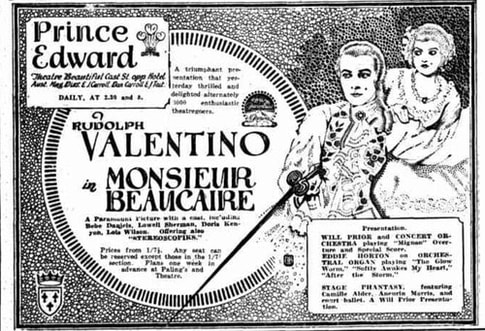 Newspaper Advertisement. Source: Sunday Times (Sydney), 2 August 1925
Newspaper Advertisement. Source: Sunday Times (Sydney), 2 August 1925
The late advent of Valentino’s fame in Australia had the effect of compressing his period of exile from the movie business during his contract dispute with Paramount. Nevertheless, Australian fans still had to wait nearly a year for his next production, Monsieur Beaucaire. In July 1925, the film began an exclusive season at the new Prince Edward Theatre, known as 'The Theatre Beautiful’, which had a policy of hand-selecting pictures of unusual quality to play extended runs. Besides the now customary lavish stage prologue, 'Stereoscopiks’, an early form of 3D film, was the supporting feature.
In America, Monsieur Beaucaire was a notorious flop. In Australia, it was a smashing success, playing the Prince Edward for ten weeks - almost certainly the longest run it had anywhere in the world.
Why did Australians embrace Monsieur Beaucaire where American audiences did not? For one, the stage play on which it was based was well known and beloved to Australians, hugely successful productions having toured the country during 1903-1904 and 1914. It remained so popular that it was not uncommon to read of Monsieur Beaucaire-themed parties amongst the society set during the early 1920s. In turn, the popularity of the film prompted a new stage production in 1926, starring Frank Harvey.
It seems that Australians also had a particular predilection for the sort of sophisticated costume fare that Monsieur Beaucaire exemplified. The operetta Viennese Nights (1930), for example, another film that most world markets had dismissed as too fey, would also find its greatest success in Australia.
In America, Monsieur Beaucaire was a notorious flop. In Australia, it was a smashing success, playing the Prince Edward for ten weeks - almost certainly the longest run it had anywhere in the world.
Why did Australians embrace Monsieur Beaucaire where American audiences did not? For one, the stage play on which it was based was well known and beloved to Australians, hugely successful productions having toured the country during 1903-1904 and 1914. It remained so popular that it was not uncommon to read of Monsieur Beaucaire-themed parties amongst the society set during the early 1920s. In turn, the popularity of the film prompted a new stage production in 1926, starring Frank Harvey.
It seems that Australians also had a particular predilection for the sort of sophisticated costume fare that Monsieur Beaucaire exemplified. The operetta Viennese Nights (1930), for example, another film that most world markets had dismissed as too fey, would also find its greatest success in Australia.
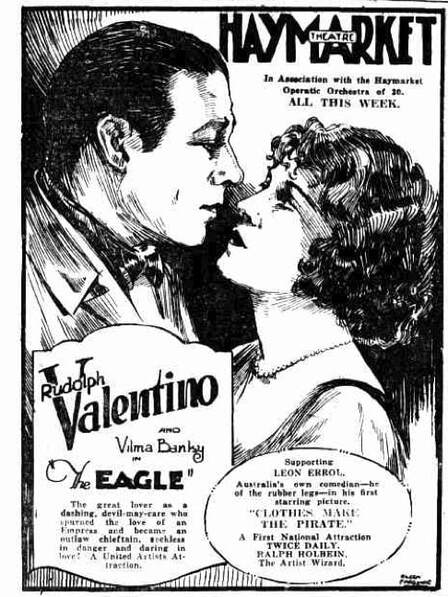 Newspaper Advertisement. Source: Sunday Times (Sydney), 21 March 1926.
Newspaper Advertisement. Source: Sunday Times (Sydney), 21 March 1926.
Though Valentino’s output slowed, his movies continued to attract enthusiastic audiences, The Eagle and Cobra both showing at three major city theatres simultaneously. After the arrival of A Sainted Devil in December 1925, fans faced another agonising wait for The Son of the Sheik, which was not scheduled to reach Australia until the end of 1926.
Only a month after The Son of the Sheik’s American debut, movie fans across Australia opened their Sunday newspapers to be met with terrible news. Valentino had collapsed and was gravely ill in hospital.
Conflicting reports in subsequent days lent hope and despair to Australian fans in equal measure, but the dreadful truth began to filter through late on 24 August, local time. By the following day, major newspapers confirmed that 'the Flapper’s Idol’ had passed away at only thirty-one years of age.
The ripple of devastation that was felt across Australia was as great as anywhere else in the world. "While a stunned world mourned, I in my little corner read through tear brimmed eyes a poem I had written after first seeing The Sheik,“ remembered a heartbroken Sue Crowley:
"Your dark eyes, speak, command, insist,
A heart of marble could not resist
Eyes that flash passion, love and fire,
Filling me with a hopeless, insane desire …”
Only a month after The Son of the Sheik’s American debut, movie fans across Australia opened their Sunday newspapers to be met with terrible news. Valentino had collapsed and was gravely ill in hospital.
Conflicting reports in subsequent days lent hope and despair to Australian fans in equal measure, but the dreadful truth began to filter through late on 24 August, local time. By the following day, major newspapers confirmed that 'the Flapper’s Idol’ had passed away at only thirty-one years of age.
The ripple of devastation that was felt across Australia was as great as anywhere else in the world. "While a stunned world mourned, I in my little corner read through tear brimmed eyes a poem I had written after first seeing The Sheik,“ remembered a heartbroken Sue Crowley:
"Your dark eyes, speak, command, insist,
A heart of marble could not resist
Eyes that flash passion, love and fire,
Filling me with a hopeless, insane desire …”
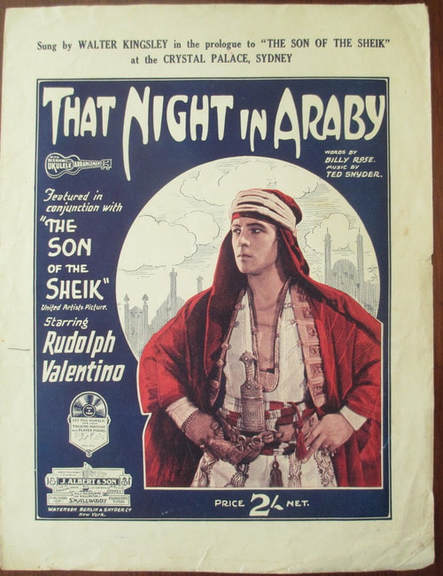 Sheet Music commemorating the Sydney release of
'The Son of the Sheik'. Source: Author's Collection.
Sheet Music commemorating the Sydney release of
'The Son of the Sheik'. Source: Author's Collection.
The Son of the Sheik, released in Australia in November 1926, was as big a success as might be expected, playing for ten weeks at the Crystal Palace. As this season came to a close, it appeared that it would mark the end of the great Valentino cult. Little did anyone know that this was only the beginning of an international fandom that continues to the present day, a century after Valentino’s debut.
“Some may say that Rudolph Valentino was not a great man—that he was but a play-actor of parts somewhat above the average; but greatness, no,” wrote The World’s News, in one of the more thoughtful Australian tributes. “Well, who shall say what greatness consists of? None, save he who understands "this scheme of things entire"—and where shall we find such a man? That man is great who, with the eyes of imagination, conceives some beautiful work of art which, carved in stone, or painted on canvas, is acclaimed by the world as a work of genius … there are great men in every walk of life, and certainly that man who succeeds in giving real pleasure to a jaded world, as Rudolph Valentino did, has some claim to greatness.”
“Though he was but thirty-one when he died, he had given pleasure to millions of people, and it is, perhaps, not too much to say that he was the most popular figure in the whole world. Few men had made more money (or spent more) than had this man whose whole life only lasted for thirty-one years. Few live so ardently. Few bring such pleasure to their fellow-men; and it is because of this that New York has witnessed such unprecedented scenes, that the whole world mourns the passing of an old familiar friend. To have achieved this is surely to have achieved greatness.”
“Some may say that Rudolph Valentino was not a great man—that he was but a play-actor of parts somewhat above the average; but greatness, no,” wrote The World’s News, in one of the more thoughtful Australian tributes. “Well, who shall say what greatness consists of? None, save he who understands "this scheme of things entire"—and where shall we find such a man? That man is great who, with the eyes of imagination, conceives some beautiful work of art which, carved in stone, or painted on canvas, is acclaimed by the world as a work of genius … there are great men in every walk of life, and certainly that man who succeeds in giving real pleasure to a jaded world, as Rudolph Valentino did, has some claim to greatness.”
“Though he was but thirty-one when he died, he had given pleasure to millions of people, and it is, perhaps, not too much to say that he was the most popular figure in the whole world. Few men had made more money (or spent more) than had this man whose whole life only lasted for thirty-one years. Few live so ardently. Few bring such pleasure to their fellow-men; and it is because of this that New York has witnessed such unprecedented scenes, that the whole world mourns the passing of an old familiar friend. To have achieved this is surely to have achieved greatness.”
